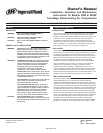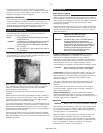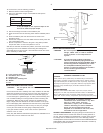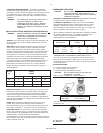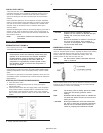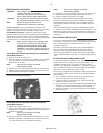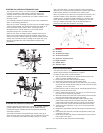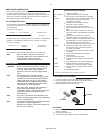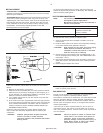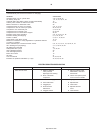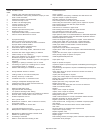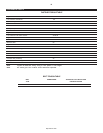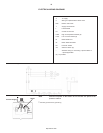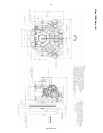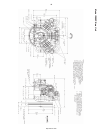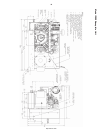
8
MAINTENANCE SCHEDULE
•
Check for oil leaks.
Daily or Before
•
Check lubricant level. Fill as needed.
Each
•
Drain receiver tank condensate (if automatic
Operation draining device is not provided). Open manual
drain valve and collect and dispose of
condensate accordingly.
•
Test drain valve for proper operation.
Clean filter screen if needed.
•
Check for unusual noise and vibration.
•
Ensure beltguards and covers are securely in
place.
•
Ensure area around compressor is free from
rags, tools, debris, and flammable or explosive
materials.
•
Check system oil pressure on pressure
lubricated models while compressor is hot.
Weekly
•
Observe operation of safety/relief valves while
the compressor is running. Replace safety/
relief valves that do not operate freely.
•
Inspect air filter element(s). Clean if necessary.
Monthly
•
Inspect for air leaks. Squirt soapy water
around joints during compressor operation
and watch for bubbles.
•
Check tightness of screws and bolts. Tighten
as needed.
•
Inspect drive belts. Adjust if necessary.
•
Clean exterior.
•
Clean drain valve filter screen.
3/500 *
•
Change petroleum lubricant while crankcase
is warm.
•
Drain compressor oil and clean oil sight glass
6/1000 *
•
Replace oil filter and change lubricant (if
necessary) on pressure lubricated modles.
12/2000 *
•
Change synthetic lubricant while crankcase
is warm.
•
Replace filter element
* indicates months/operating hours, whichever occurs first.
FILTER INSPECTION & CLEANING
1. Loosen the clamps securing the filter housing to its base.
2. Remove the filter housing and withdraw the old filter element.
Clean the element with a jet of air or vacuum.
3. Replace the filter element and housing.
OIL CHANGE
1. Remove the oil drain plug and allow the lubricant to drain into a
suitable container.
2. Replace the oil drain plug.
3. Follow the filling procedures in INSTALLATION section.
BREATHER/UNLOADER BY-PASS
The breather/unloader by-pass tube lines eliminates air pressure build-
up in the compressor frame by providing a passage for the air to
escape through the inlet unloader (if opened) or (if closed) through the
check valve, therefore, by-passing the inlet unloader and escaping to
atmosphere through the inlet filter/silencer.
OIL CONSUMPTION CHECK
A rule of thumb in determining a “passing grade” for oil consumption is
to consider consumption at or above 50 horsepower-hours per ounce
to be acceptable.
The formula is as follows:
Horsepower X Hours of Operation = Horsepower Hours
Ounces of Oil Used per Ounce
To apply this formula, consider the size of the machine. In the following
example, a 5 horsepower compressor uses 2 ounces of oil every
20 hours of operation.
5 Horsepower X 20 Hours of = 50 Horsepower
Operation Hours per Ounce
2 Ounces of Oil Used
The compressor in the example passes the oil consumption test.
NOTE New or rebuilt compressor pumps will
discharge higher than normal amounts of oil
until the piston rings are seated
(approximately 100 operating hours).
MAINTENANCE
aWARNING Before performing maintenance, release air
pressure from the system and disconnect,
lock and tag the main power supply or
disconnect the wire from the engine spark
plug.
NOTE All compressed air systems contain
maintenance parts (e.g. lubricating oil, filters,
separators) which are periodically replaced.
These used parts may be, or may contain,
substances that are regulated and must be
disposed of in accordance with local, state,
and federal laws and regulations.
NOTE Take note of the positions and locations of
parts during disassembly to make
reassembly easier. The assembly sequences
and parts illustrated may differ for your
particular unit.
NOTE Any service operations not explained in this
manual should be performed by an authorized
service representative.
NOTE The following maintenance schedule has been
developed for typical applications.
Maintenance intervals should be shortened in
harsher environments.
81295669
81295651
http://air.irco.com



